Overview
Within This Page
Physical comfort is critical to work effectiveness, satisfaction, and physical and psychological well-being. During the facility design and development process, to ensure comfortable environments, building projects must have a comprehensive, integrated perspective that seeks to:
- Provide a superior acoustic environment
- Maintain optimal thermal comfort
- Create a high quality visual environment
- Provide furniture and equipment that will enhance worker comfort and performance
- Provide user controls.
Implementing holistic design principles will also help achieve these objectives.
Uncomfortable conditions in buildings and spaces-too hot, too cold, too noisy, too dark, too light, too much glare-restrict the ability of workers to function to full capacity and can lead to lowered job satisfaction and increases in illness symptoms.
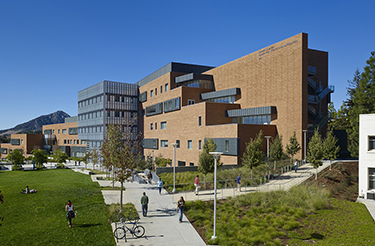
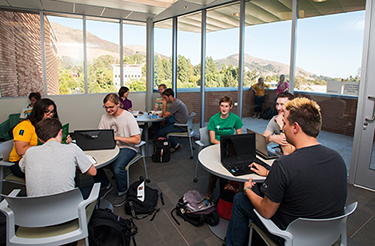
The Warren J. Baker Center for Science and Mathematics at Cal Poly, San Luis Obispo, California was a 2017 Livable Building Award winner, performing above the benchmark in every core category of the program including thermal comfort and acoustics. Interior open space was provided for studying and gathering as shown at right. Photos courtesy of ZGF Architects
Recommendations
Provide a Superior Acoustic Environment
- Reduce sound reverberation time inside the workplace by specifying sound absorbing materials and by configuring spaces to dampen rather than magnify sound reverberation.
- Provide sound masking if necessary.
- Specify acoustical ceilings or ceiling tiles with a noise reduction coefficient (NRC) of 0.75.
- Limit transmission of noise from outside the workplace by designing high sound transmission class (STC) walls between work areas and high noise areas inside and outside the building.
- Minimize background noise from the building's HVAC system and other equipment.
- Provide opportunities for privacy and concentration when needed in open plan offices.
- Enclose or separate group activity spaces from work areas where concentration is important.
Provide Quality Thermal and Ventilation Comfort
- At a minimum, comply with American Society of Heating, Refrigerating and Air Conditioning Engineers (ASHRAE) Standard 55 Thermal Environmental Conditions for Human Occupancy.
- Incorporate natural ventilation, if appropriate to the location, and consider adjusting the requirements of ASHRAE Standard 55 to account for the impact.
- Analyze room configurations and HVAC distribution layouts to ensure all parts of a room are receiving adequate ventilation, especially spaces where teams or groups meet. Consider providing individual environmental controls in these rooms.
- Analyze placement, configuration, and type of windows and skylights and provide adequate, controllable shading to avoid "hot spots" caused by direct sunlight.
- Consider providing a temperature and humidity monitoring system to ensure optimal thermal comfort performance.
- Evaluate the use of access floors with displacement ventilation for flexibility, personal comfort control, and energy savings.
- Provide individual air and temperature controls at each workstation.
- Utilize CO2 sensors to assess the air quality of spaces to adjust ventilation.
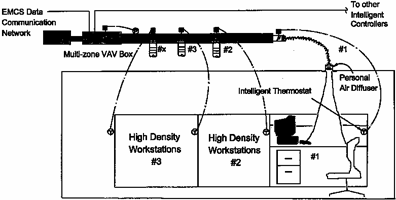
One solution for providing quality thermal and ventilation comfort is enhanced ventilation terminal control system with multi-zone VAV box terminal controls and individual airflow controls (personal air-conditioning). Photo Credit: Public Works Government Services Canada, Innovations and Solutions Directorate
Create a High Quality Visual Environment (Including Lighting, Daylighting, and Visual Interest)
- Provide as much natural daylight as possible for occupants while avoiding excessive heat loss, heat gain, and glare.
- Provide views and access to the outdoor environment for all occupants.
- Provide connections to indoor and outdoor nature where possible.
- Integrate natural and electric lighting strategies, and provide controls that optimize daylighting/electric lighting interaction. Light vertical surfaces/walls to increase the perceived brightness of the space.
- Balance the quantity and quality of light in all work areas and design for "uniformity with flexibility." Consider individually controlled task lighting for each workstation that properly illuminates the task.
- Control or eliminate glare from ceiling lighting and windows.
- Provide individual control of task lighting and, where possible, adjustment of ceiling light using advanced lighting systems technologies.
- Assure a visually appealing environment through the appropriate and well-balanced use of scale, colors, textures, patterns, artwork, and plants.
- Avoid both uniformity and visual chaos.
- See also WBDG Psychosocial Value of Space.
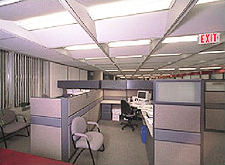
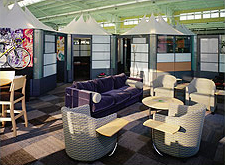
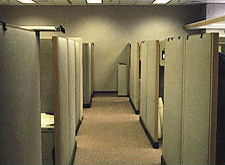
Low-glare retrofit lenses, C. D. Howe Building, Ottawa, Ontario, Canada. Photo Credit: Public Works Government Services Canada, Innovations and Solutions Directorate
Workplace environments with well balanced color and patterns are pleasant and appealing. This photo shows an informal work area at the Herman Miller Front Door in Holland, Michigan.
The beige cubicle environment lacking color embellishment or pattern is, unfortunately, a common site in many work environments and not an optimal one. The high partitions block daylight from enlivening the space.
Provide Furniture and Equipment that Will Enhance Worker Comfort and Performance
- Adapt furnishings to the work to be done, not the other way around.
- Specify furnishings that support good posture, body mechanics, and work techniques for the tasks to be accomplished (e.g. ergonomically designed chairs and keyboards).
- Provide workstations that allow users to adjust seating, computer equipment placement, light levels, work surface heights, workspace layout, and ventilation.
- Install glass panels in workstation walls to provide access to daylight and views.
- Design furniture configurations that allow workers variable views for visual relief.
- For telecommuting workers, the sponsoring organization should assure that the home office is comfortable, ergonomic, and has the necessary technological tools.
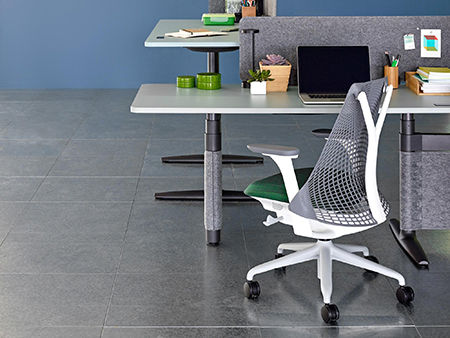
Ergonomic office chair and adjustable work table
Provide User Controls
- Divide the building and/or spaces up into smaller zones with local zone terminal units to allow each zone to react individually to local conditions or different user preferences for airflow or temperature.
- Incorporate lighting controls to achieve a high quality energy efficient lighting system, while also allowing for individual lighting preferences or needs.
Relevant Codes and Standards
- ASHRAE Standard 55 Thermal Environmental Conditions for Human Occupancy
Additional Resources
Provide a Superior Acoustic Environment
- Acoustical Society of America
- American Speech-Hearing-Language Association
- Greening Federal Facilities: An Energy, Environmental, and Economic Resource Guide for Federal Facility Managers and Designers (p. 123)
- PBS-P100 Facilities Standards for the Public Buildings Service (Chapter 3.13)
- Institute of Noise Control Engineering of the USA
- National Council of Acoustical Consultants
- National Research Council of Canada
- NIH Design Policy and Guidelines: 1996–2000
- TM 5-803-2/NAVFAC P-970/AFM 19-10 Environmental Protection Planning in the Noise Environment
- UFC 3-120-10 Interior Design
- UFC 3-450-01 Noise and Vibration Control
Maintain Optimal Thermal Comfort
- American Society of Heating, Refrigerating and Air Conditioning Engineers (ASHRAE)
- Center for Building Performance and Diagnostics, Carnegie Mellon University
- Center for the Built Environment, University of California-Berkeley
Create a High Quality Visual Environment
- The DesignLights Consortium™
- ENERGY STAR®—EPA
- Greening Federal Facilities: An Energy, Environmental, and Economic Resource Guide for Federal Facility Managers (p.37, p.121)
- Illuminating Engineering Society (IES)
- Lawrence Berkeley National Laboratory
- Lighting Research Center, Rensselaer Polytechnic Institute
- Light Right Consortium, Battelle/Pacific Northwest Laboratory
- UFC 3-530-01 Design: Interior and Exterior Lighting and Controls










